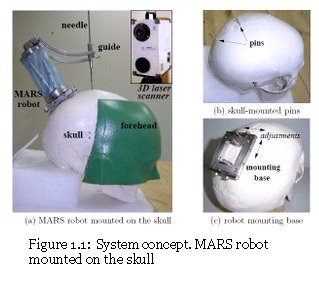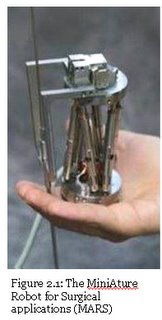 Keyhole surgery involves operating through tiny incisions. Although large incisions enable the surgeon to better see and manipulate the pathological tissue, unnessary damage are often done to the organ causing greater pain to the patient and longer recovery time. There is also a higher risk of complications due to surgical trauma. Thus, the need for Minimally Invasive Surgery (MIS) yields a considerable amount of research in the field of medical robotics.
Keyhole surgery involves operating through tiny incisions. Although large incisions enable the surgeon to better see and manipulate the pathological tissue, unnessary damage are often done to the organ causing greater pain to the patient and longer recovery time. There is also a higher risk of complications due to surgical trauma. Thus, the need for Minimally Invasive Surgery (MIS) yields a considerable amount of research in the field of medical robotics.
Figure 1.1, taken from a research thesis, illustrates a novel image-guided system use for minimally invasive neurosurgery. The system consists of a miniature robot holding a mechanical guide for needle or probe insertion. Based on a preoperative CT/MRI image, the robot can automatically positions itself for accurate targeting or path finding along the skull of the patient.
 Currently, such a system is still in research or refining stages in neurosurgery and the MARS robot is rather more commonly used in orthopedic procedures. Clearly, the use of miniature robot provides many advantages over existing bulky and expensive robotic system. The miniature robot system has no size and line-of-sight problems and insertion angles are not being restricted as the robot has 6 degree of freedom. Being robust and small, the system is not only more affordable but allows for easy use and change of plans prior to, or even during, the actual surgical operation.
In addition, such a system does not require immobilization of the patient as the robot is mounted on the skull is based on a relative reference frame. The mounting frame also provides rigid and robust support for precise guidance of needle insertion.
In the likely future, we shall see the broader use of smaller yet more precise robots in the field of medicine.
Currently, such a system is still in research or refining stages in neurosurgery and the MARS robot is rather more commonly used in orthopedic procedures. Clearly, the use of miniature robot provides many advantages over existing bulky and expensive robotic system. The miniature robot system has no size and line-of-sight problems and insertion angles are not being restricted as the robot has 6 degree of freedom. Being robust and small, the system is not only more affordable but allows for easy use and change of plans prior to, or even during, the actual surgical operation.
In addition, such a system does not require immobilization of the patient as the robot is mounted on the skull is based on a relative reference frame. The mounting frame also provides rigid and robust support for precise guidance of needle insertion.
In the likely future, we shall see the broader use of smaller yet more precise robots in the field of medicine.
4 comments:
Neurosurgery is a highly dangerous surgery and any mistake could cause death. This robot may seem to be a remarkable invention,but the most important question is how reliable and safe this robot is and given the complexity of the brain ,how it could adapt to different surgeries.
From Tan Sze Sze Vivian U037841J
Yes. I agree that neurosurgery is a dangerous operation. Before a piece of medical equipment is used on humans, it must undergo the required tests, before being deemed safe to use. These tests have been quoted as standards by the world body on medical safety. What I am concerned is that the patient is awake while the operation is being done. That could be quite a problem considering that the patient is not in a calm state during the operation.
Imagine popping into the clinic to get a quick fix for your flu, only to have the doctor remind you of the annual health check that you have been postponing indefinitely. He proceeds to offer an old adage, “Prevention is better than cure”, thus insinuating that you are deliberately delaying the health check. You smile meekly and apologize, yet again, as you show him your organizer (the one that is filled to the brim with appointments). You start feeling depressed. Is it depressing because you feel powerless in the presence of your doctor, or is it depressing because you suddenly realize that you have no time at all to spend on yourself?
If you are depressed because you feel powerless in the presence of your doctor, there is really nothing anybody can do about that. However, if you feel depressed knowing that you have no time at all to spend on yourself, rejoice in the fact that machines, especially robots, have always found ways to allow us to accomplish more in less time.
On the topic of Minimally Invasive Surgery (MIS), researchers have come up with a miniature robot prototype that can be inserted through an incision. The robot can then be freely controlled to perform medical treatment and capture images when necessary. The prototype currently has image capture functions, medicine delivery systems, and tiny forceps for taking tissue samples. The possibilities are endless for this robot. With robots like these, it is possible to have health checks conducted when you are having lunch, and if there is a television, you get to enjoy the afternoon news.
That’s what you call multi-tasking!
That was me.
Brought to you by,
Nick (U045902U)
Post a Comment